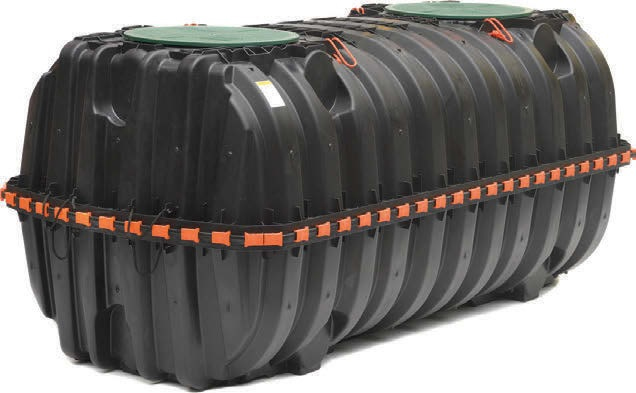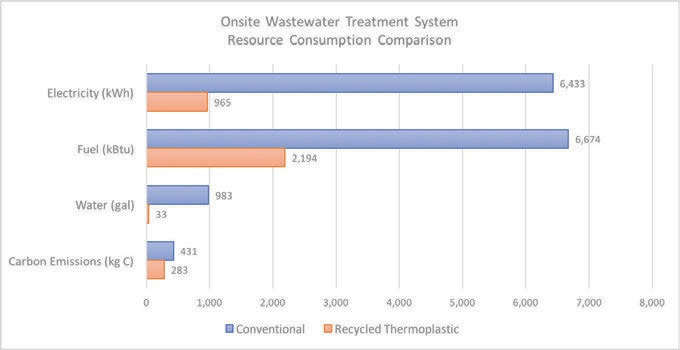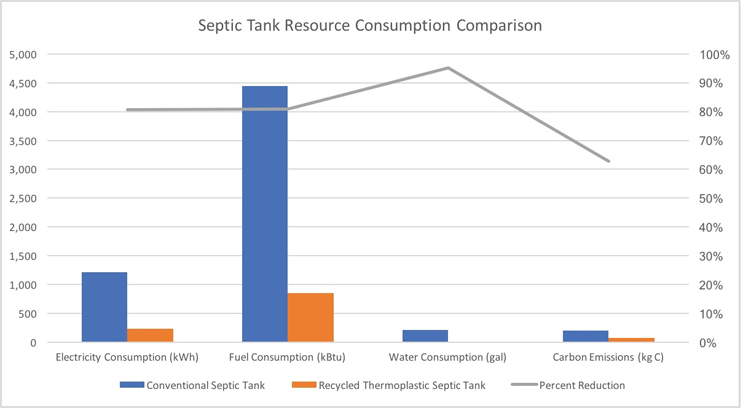Quantitative Analysis Of Onsite Wastewater Treatment System Environmental Impact
By Jonathan Kaiser
Environmental protection is at the heart of wastewater treatment, but the treatment system itself has a footprint. Here, a comparative analysis of the resource consumption of conventional and recycled thermoplastic systems is provided.
Concern is growing globally over natural resource consumption and climate change. Many governments, companies, and industries are acting to reduce the environmental effects associated with material and product manufacture and processing. Both natural resource consumption and greenhouse gas emissions are being monitored and analyzed closely as resource shortages and greenhouse gas emissions continue to rise globally.
Septic systems have conventionally consisted of a precast concrete septic tank, followed by a gravel and pipe drainfield. Although these materials have provided adequate treatment and dispersal of wastewater for many years, they are energy and resource intensive to manufacture and manage.
By weight, concrete is composed of approximately 15 percent cement and 85 percent aggregates. Cement is manufactured from limestone and clay using a process known as calcination, which is energy-intensive due to the amount of heat required and releases carbon dioxide, a greenhouse gas. The conventional septic system, therefore, relies upon mining and processing natural gravel resources, a nonrenewable process (DOT FHWA, 2012).
Calcination involves heating limestone (primarily calcium carbonate, CaCO3) to form calcium oxide (CaO) and carbon dioxide (CO2), as shown in Equation 1. When combined with clay, often containing aluminum silicate (Al2SiO5), the products become alite (3CaO·SiO2), aluminum oxide (Al2O3), and carbon dioxide, as shown in Equation 2. Aluminum oxide and alite are two of the main components of cement (MAST, 1995).
1. CaCO3 + heat → CaO + CO2
2. 3CaCO3 + Al2SiO5 + heat → 3CaO . SiO2 + Al2 O3 + 3CO2

The manufacture of cement is therefore both energy-intensive (heat) and high in greenhouse gas emissions (CO2). Of the total carbon dioxide emitted by the U.K.’s concrete industry, approximately 85 percent is estimated to be from the manufacturing of cement; 60 percent of these emissions are estimated to be from the calcination process, and 40 percent from fuel combustion to heat the limestone and clay (Concrete Centre, 2009).
Gravel quarries typically begin the mining process by blasting or drilling into the landscape using heavy machinery to extract large particles from the ground. These are then sent through a series of machines to crush and screen the natural aggregate into variously sized stockpiles. Depending on its intended use, the aggregate often must be thoroughly washed to ensure it is free of small-diameter rock and soil particles referred to as fines. The mining process therefore involves a large amount of fuel and water consumption to run the machinery and wash the aggregate, in addition to the substantial amount of natural resource consumption (USEPA, 2004).
Alternative materials have been recently introduced to the septic industry, using recycled thermoplastic to manufacture septic tanks and drainfield products (i.e., chambers). The manufacture of recycled thermoplastic products involves the removal of waste plastic from landfills and junkyards, processing the plastic, melting the regrind to liquid plastic, and molding products using electric machinery. While these products have been qualitatively considered environmentally friendly by using recycled materials, the goal of this analysis is to quantitatively compare the manufacture, production, and transportation of both conventional concrete/aggregate septic systems and a system of recycled thermoplastic components.

Comparative Analysis Methods
For this quantitative analysis, the conventional spetic system is defined as a 1,000-gallon precast concrete septic tank and a 1,000-square-foot stone drainfield using 3” polyvinyl chloride piping for distribution of the wastewater. The recycled thermoplastic system is defined as Infiltrator Water Technologies’ (Infiltrator) IM-1060 septic tank and a 1,000-square-foot drainfield of Quick4 EQ36 chambers at a 1:1 sizing with a conventional system. Analysis included raw material processing, manufacture of the finished product, and transportation of the product to the field installation site. Resources compared were water, electricity, and fuel.

For the conventional system, the transportation distance was assumed to be 30 miles to account for availability of local materials; for each conventional system, one truck is carrying one septic tank and one truck is carrying the amount of stone required for the 1,000-square-foot drainfield, and each travels 30 miles to deliver the conventional system to the work site. Published unit value conversions for mining and cement production were used to calculate water, electricity, and fuel use.
In calculating resource consumption of the recycled thermoplastics system, a flatbed transportation distance of 1,000 miles was used to account for the distance from the manufacturing plant to a distributor. A distance of 30 miles was then used to calculate the distance traveled from the distributor to the installation site in two pickup trucks total — one transporting the septic tank and one transporting the Infiltrator chambers. Infiltrator’s Winchester, KY, manufacturing facility’s water, electricity, and fuel usage data was monitored for six months and used for the analysis. Values for electricity use, fuel consumption, water consumption, and carbon emissions were calculated using the published unit value conversions for both systems.
Conventional vs. Recycled Thermoplastic Systems
The recycled thermoplastic septic tank and drainfield consumes significantly fewer resources and emits fewer carbon emissions than the conventional septic system. The recycled thermoplastic system consumes 85 percent less electricity, 67 percent less fuel, and 97 percent less water and emits 34 percent less carbon than the conventional septic system. In an analysis where the distances between manufacturing and final installation site are at equal distances for conventional and recycled thermoplastic systems, the resource and emissions savings are even greater for the recycled thermoplastic systems.
The majority of fuel and emissions savings for the thermoplastic system are from the septic tank alone. The thermoplastic septic tank uses 81 percent less fuel and releases 63 percent fewer carbon emissions than the concrete septic tank. This is largely due to the high level of energy for the cement manufacturing process involved in the concrete tank production. For conventional septic systems, cement production accounts for 39 percent of the total fuel consumption and carbon emissions.
Electricity and water savings are slightly higher through drainfield comparison. This is expected due to the high level of electricity use in PVC production (71 percent of total conventional system usage) and high water consumption in aggregate processing (70 percent of total conventional system usage).
Conclusion
In every analysis, the recycled thermoplastic system consumes fewer resources and emits less carbon into the atmosphere than the conventional system, regardless of distance traveled from manufacturing to the final installation site or system component. It can therefore be concluded that the use of recycled thermoplastic septic system products is a more sustainable approach to onsite wastewater treatment than conventional septic systems. When compared to the total number of septic systems installed each year in the U.S. (26.1 million in 2007), this could amount to a total yearly savings of 143 billion kWh of electricity, 117 billion kBtu of fuel, 10.7 billion gallons of water, and 4.3 million tons of carbon if every septic system were composed of recycled thermoplastics rather than conventional materials.
About The Author
 Jonathan Kaiser (jkaiser@infiltratorwater.com), a project engineer for Infiltrator Water Technologies (Infiltrator), joined the company in 2016 after graduating with his BS in environmental engineering from the University of Vermont. He spends his time at Infiltrator working on septic system design, product regulation, and research and development initiatives.
Jonathan Kaiser (jkaiser@infiltratorwater.com), a project engineer for Infiltrator Water Technologies (Infiltrator), joined the company in 2016 after graduating with his BS in environmental engineering from the University of Vermont. He spends his time at Infiltrator working on septic system design, product regulation, and research and development initiatives.
